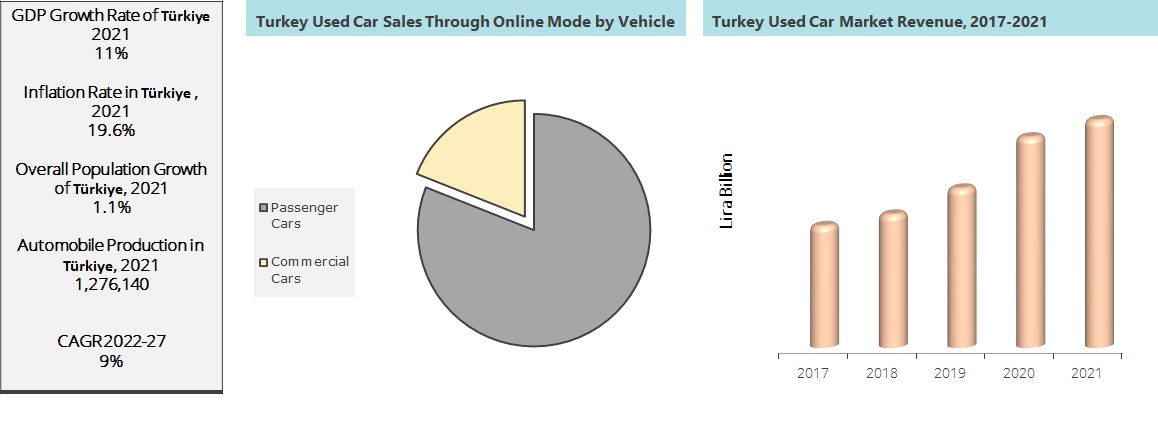Report Store Details
- Home
- Report Store Details

Turkey Used Car Market Revenue and Forecast to 2027
- 23 Jul 2022
- Report Code: MK20494
- No of Pages: 75
Price From: $1350
- Description
- Table Of Content
- Request Free Sample
Executive Summary
Turkey used car market has experienced a rapid expansion in recent years, with passenger cars making up the majority of demand as compared to commercial vehicles. Used automobile sales during the pre-COVID period increased by 21.99% whereas country’s economy saw a sharp decline in employment and consumer spending after the virus outburst.
Turkey Automotive Industry plays a very important role in the manufacturing sector of the nation’s economy. Marmara Region is the main operating destination for the Turkish Automotive sector. Turkey is the 14th largest automotive industry in the world and 4th in the European Region with an average export rate.
The Turkey Used Car market was valued at Lira XXX billion in 2021 and it is expected to reach Lira XXX billion by 2027 registering a CAGR between 6%-9% in next five years. The market witnessed a positive growth during the year 2020 despite a significant decline in volume sold in 2021, market revenues have recorded XX% growth as a result of a steep rise in used car prices owing to rising inflation.
Gap in Demand-Supply Led to Rise in Price: The prices of used cars have become higher than the brand-new ones over the last few years. There was shortage of supply in the initial months of 2020 owing to excessive demand in the last quarter of 2019 as supplier’s failed to foresee the increased demand in the first quarter of 2019 and were not able to prepare for the first quarter of 2020 entailing the cascading effect, making the prices of used car higher comparing to the prices of brand-new ones.

Scope of the Study
The following synopsis is based on the report published by Makreo Research titled "Turkey Used Car Market and Future Forecast to 2027". The report delves deeply into various parameters such as market size, segmentation, value chain analysis, and effect analysis. The study includes market dynamics that provide an understanding of industry opportunities, driving forces, major challenges impeding growth, and an analysis of future opportunities that may help market players capitalise on untapped business potential in the specific geography.
Turkey Used Car Market Coverage
- Turkey Automotive Trade Performance
- Automobile Market of Turkey
- Used Car Market Revenue and Forecast
- Volume Demand of Used Cars in Turkey
- COVID-19 Impact over Turkey Used Car Market
- Driving Forces and Major Market Restraints
- Key Economy Variables have an Influence over the market
The report helps reader to gain information on following areas:
- How Turkey used car market has performed in the past and what is the current scenario?
- How Turkey Automobile industry is performing and what is the ratio of used cars vs new cars demand?
- What are the market driving forces of Turkey Used Car market that are helping the industry growth and what are the key challenges ahead?
- Which is the dominant car type in the Turkey used car market having maximum shares?
- What was the impact of COVID-19 over the used car demand in 2020 and what impact has it left over the future industry growth?
- What are the key variables responsible for Turkey used car pricing?
- What is the volume growth of online used car market in Turkey?
- What is the Turkey used car market revenue?
- What is the role of inflation in used car market and how used car prices varied in last few years?
- According to best case scenario what is the expected future of used cars in Turkey?
Table of Content
Report Synopsis
Industry Overview
Impact of COVID-19 over Turkey Economy
1. Research Methodology
1.1 Objective of the Study
1.2 Research Process
1.3 Data Collection Methods
1.4 Analytical Framework
2. Turkey Country Analysis– EPTD Analysis
2.1 Country Analysis- EPTD Analysis
2.2 EPTD Analysis: Economy Overview
2.3 EPTD Analysis: Political Overview
2.4 EPTD Analysis: Technological Overview
2.5 EPTD Analysis: Demographic Overview
3. Turkey Trade Performance
3.1 Turkey Trade Performance – Pre COVID-19 Scenario
3.2 Turkey Import/Exports – Key Stats
3.3 Turkey Trade Performance: Post Covid Scenario – Trade in 2020
3.4 Turkey Trade Performance: Post Covid Scenario
3.5 Turkey Automotive Sector Trade Performance: Post Covid Scenario – 2020
3.6 Turkey Automotive Sector Trade Performance: Post Covid Scenario – 2021
3.7 Turkey Automotive Sector Trade Statistics
4. Turkey Automobile Market Performance
4.1 Turkey Automobile Market – An Overview
4.2 Turkey Automobile Market – Key Facts
4.3 Turkey Automobile Market –Sales Facts
4.4 Turkey Automobile Production Facts
4.5 Turkey Automobile Demand and Supply Facts – Post COVID-19
5. Turkey Used Car Market Analysis and Future Forecast
5.1 Turkey Passenger Car Market - An Overview
5.2 Turkey Used Car Market – Key Facts
5.3 Turkey Used Car Market Performance
5.4 Turkey Used Car Market Performance – Before Virus Outbreak
5.5 Impact of COVID-19 over Automobile Industry
5.6 Impact of COVID-19 over Turkey Used Car Demand
5.7 Turkey Used Car Market Performance – Pre and Post COVID Demand Assessment
5.8 Turkey Used Car Market – Key Statistics
5.9 Inflation Vs Turkey Used Car Prices
5.10 Soaring Used Car Prices
5.11 Turkey Used Car Market Revenue and Forecast
5.12 Turkey Used Car Market Future Outlook
5.13 Emerging Technology Driving the Future Growth of Used Car in Turkey
5.14 Major Brands in Demand
6. Turkey Used Cars Market Dynamics
6.1 Industry Driving Forces
6.2 Industry Trends & Developments
6.3 Industry Challenges
7. Turkey Used Car Market – Macro-Economic Factors
8. Limitations of the Study

